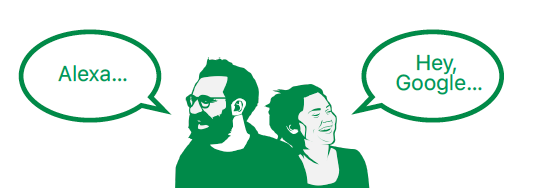

Over the last year, smart assistants like the Amazon Echo and Google Home have become some of the top tech devices. The evolution from early voice assistants, only capable of simple commands, to multi-featured smart assistants has attracted a wider audience. As these constantly-learning smart AIs are becoming more deeply integrated into our world, it is important for our research team to know and understand the average customer journey; from when they unbox the device to usage.
The Technophile Customer Journey Map
Specifically, we have been keeping an eye on usage, beliefs and opinions of today's Technophiles; an enthusiast of technology. A Technophile is the early adopter of new technology, the “tech-savvy”, and the “tech-eager”. Early adopters have always been an important part of technology. They purchase new technology first and immediately become natural evangelists who will share their experience. The Technophiles are often current with technology and trends, and expect a simple and intuitive end-to-end experience when engaging with new tech products. Just because they are tech-savvy, does not mean that they want to spend time troubleshooting. Technophiles expect the technology to be built well so that they can easily start using, playing with it and evaluating its performance. These users are often the first to share their opinions on new technology. They enjoy talking about new technology that has worked well for them, but also will warn others about devices that they find to miss the mark.
About the Customer Journey
To study smart assistants, KLI invited 11 participants who fit this persona to track and provide feedback using Experience Fellow, a mobile app that lets participants take pictures, record videos, and write feedback about their journey interacting with the device. Six of them used a Google Home, and 5 used the Amazon Echo. Participants were asked to document their journey from unboxing and first impressions, to setup, through usage.
First, the participants unboxed their smart assistant. Immediately they were excited about the new technology and reported that they were looking for the packaging to invite them to both use the product and want to use the product. Their expectation is such that the packaging should build up the product, present it well, and provide any relevant information in a simple and concise way. The Google Home and Amazon Echo both had packaging that reportedly lived up to the hype; participants were excited and happy to use the product, they said that the packaging was clear, simple and elegant. Specifically, some of the Google Home participants felt that the packaging was a bit clunky, but overall they liked it. Amazon Echo users mentioned that the box colors and design were really nice and they really appreciated the included onboarding materials.
Next, participants set out to set up their smart assistant. Technophiles are looking for the setup to be easy and minimal, they want any information to be clearly communicated/displayed. Technophiles see the setup as an obstacle between them and the device, so any time spent lost or troubleshooting is frustrating. During their experience they discovered a long contract in the setup and onboarding experience for both Home and Echo users. Google Home participants said they had a simple setup experience using the Google Home app and although there was some confusion, they were determined and excited to start. On the other hand, while Echo users were also excited to start using their new device, they experienced a lot of problems with the Echo mobile app, were disappointed and found themselves fumbling to get started.
After the setup process was completed, the participants were able to start using their device. This was clearly the exciting and fun part of their journey. They started by exploring the device and learning how to use it. They were seeking interactions that were easy, intuitive, and felt like the flow of a normal human conversation. Technophiles are known to be quick studies, they pick up on technology and the commands quite easily, yet, they still want to interact with the device naturally. During the initial exploration phase participants were testing the device by performing random tasks such as asking for a joke, news, sports inquires, playing animal sounds, and more. They were happy during this phase and had some fun with their device. However, once participants attempted more complex interaction with the device, things changed.
Specifically, participants were asked to order a pizza with their smart device. Ideally, they were to easily connect with a pizza app and order a pizza. Users reported that this task took a long time to master (a few said 10-20 minutes). They found it to be difficult because the experience is limited in some ways (for example: Domino’s only allows one to reorder a previous order), and that it did not ultimately simplify the process of ordering a pizza at all. Participants were frustrated because they could have called and ordered the pizza in a fraction of the time it took for them to do so with the help of the smart assistant.

Pain Points/Important Factors
There were many pain points and opportunities for recovery at each stage of the user’s journey. During the First Impressions stage, participants were seeking an unboxing and process that was simple and exciting. This means that any irrelevant or redundant materials should be removed and any important information (ie. a required app) should be clearly shown or communicated. During the Setup process, participants reported feeling unsure and were lost and confused when they didn’t know where to find important information. They found it to be particularly annoying to have to search online for the answers to their questions. Finally, during the Usage phase, participants felt that although the device was fun to use at first, the more complex the interactions, the less helpful the device was to them. Generally, users want this technology to simplify tasks. Requiring complex interactions produces a complex experience. Users were uneasy and didn’t trust the device when they felt they didn’t understand its capabilities. When the steps to complete a task aren’t intuitive, are unclear, limiting, or too long compared to the traditional way of completing the task, they are let down.
The State of The Industry
The Google Home and Amazon Echo are clearly market leaders for smart home/assistant technology, but observation of their use by Technophiles indicated that they aren’t quite producing a truly painless user experience. It is important to remember that users do not want to feel like they are talking to a robot, they do not want to feel limited by the device, and they want their interactions with the device to simplify tasks in their daily lives. While participants like to use these devices and are very satisfied when it correctly reacts to a command, incorrect responses or failure to simplify a process causes a lot of friction for users. It is critical to not only have a robust AI that can carry out many actions, but it must also satisfy users desire to be part of a simple and seemingly natural process.
Click to see the full CJM: SMARTLIFE Customer Journey Map
READ MORE: Getting Started With Customer Journey Mapping, A Consumer Journey: Samsung Gear Neo, 11 Tips to Develop Your User Empathy Journey Map, Methods for Running a Successful Diary Study










Comments
Add Comment